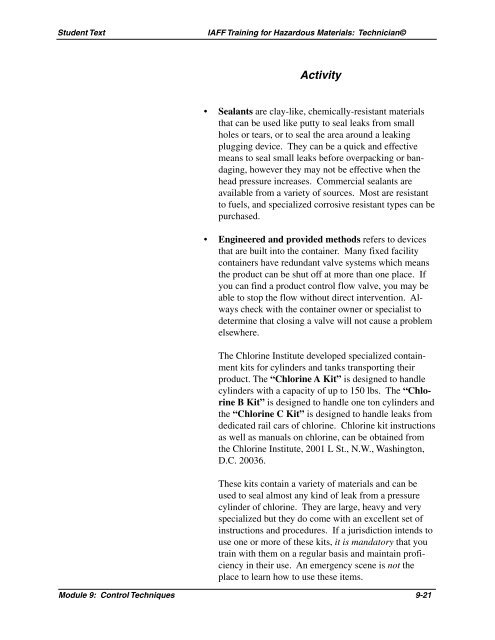Module 9: Control Techniques - International Association of Fire ...
Module 9: Control Techniques - International Association of Fire ...
Module 9: Control Techniques - International Association of Fire ...
You also want an ePaper? Increase the reach of your titles
YUMPU automatically turns print PDFs into web optimized ePapers that Google loves.
Student Text IAFF Training for Hazardous Materials: Technician©<br />
Activity<br />
• Sealants are clay-like, chemically-resistant materials<br />
that can be used like putty to seal leaks from small<br />
holes or tears, or to seal the area around a leaking<br />
plugging device. They can be a quick and effective<br />
means to seal small leaks before overpacking or bandaging,<br />
however they may not be effective when the<br />
head pressure increases. Commercial sealants are<br />
available from a variety <strong>of</strong> sources. Most are resistant<br />
to fuels, and specialized corrosive resistant types can be<br />
purchased.<br />
• Engineered and provided methods refers to devices<br />
that are built into the container. Many fixed facility<br />
containers have redundant valve systems which means<br />
the product can be shut <strong>of</strong>f at more than one place. If<br />
you can find a product control flow valve, you may be<br />
able to stop the flow without direct intervention. Always<br />
check with the container owner or specialist to<br />
determine that closing a valve will not cause a problem<br />
elsewhere.<br />
The Chlorine Institute developed specialized containment<br />
kits for cylinders and tanks transporting their<br />
product. The “Chlorine A Kit” is designed to handle<br />
cylinders with a capacity <strong>of</strong> up to 150 lbs. The “Chlorine<br />
B Kit” is designed to handle one ton cylinders and<br />
the “Chlorine C Kit” is designed to handle leaks from<br />
dedicated rail cars <strong>of</strong> chlorine. Chlorine kit instructions<br />
as well as manuals on chlorine, can be obtained from<br />
the Chlorine Institute, 2001 L St., N.W., Washington,<br />
D.C. 20036.<br />
These kits contain a variety <strong>of</strong> materials and can be<br />
used to seal almost any kind <strong>of</strong> leak from a pressure<br />
cylinder <strong>of</strong> chlorine. They are large, heavy and very<br />
specialized but they do come with an excellent set <strong>of</strong><br />
instructions and procedures. If a jurisdiction intends to<br />
use one or more <strong>of</strong> these kits, it is mandatory that you<br />
train with them on a regular basis and maintain pr<strong>of</strong>iciency<br />
in their use. An emergency scene is not the<br />
place to learn how to use these items.<br />
<strong>Module</strong> 9: <strong>Control</strong> <strong>Techniques</strong> 9-21
















